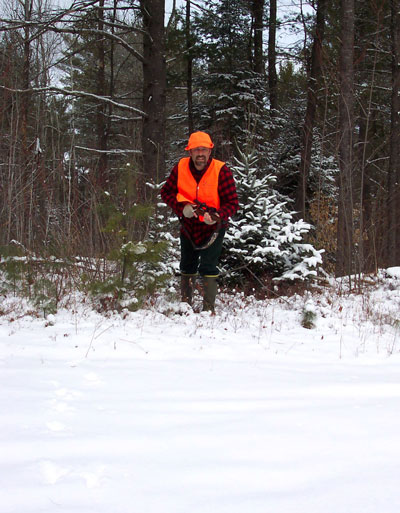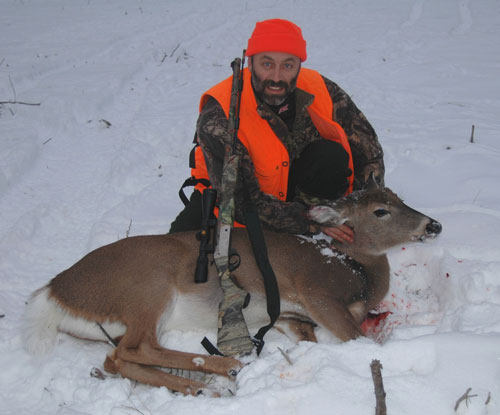Moving Along
 Perhaps the trickiest aspect of tracking is knowing how fast or slow to move. It depends partly on track age. The fresher the track, the slower you move. You should also study the buck’s track and see what it’s telling you. Long strides on a relatively straight course usually means he’s lining out, and you’ve got some ground to make up. If he was milling about, feeding, you might want to go slowly. If he was following a doe, you need to go on red alert. She probably won’t travel far and neither will he. Plus, she might attract other bucks.
Perhaps the trickiest aspect of tracking is knowing how fast or slow to move. It depends partly on track age. The fresher the track, the slower you move. You should also study the buck’s track and see what it’s telling you. Long strides on a relatively straight course usually means he’s lining out, and you’ve got some ground to make up. If he was milling about, feeding, you might want to go slowly. If he was following a doe, you need to go on red alert. She probably won’t travel far and neither will he. Plus, she might attract other bucks.
Know the rut phase. Outside of the rut, an old buck’s primary objective is security. That means thick cover. He’ll bed where he can see you but you can’t see him, usually with the wind at his back and an open view in front, and often on higher ground. During the rut he’ll bed where the does bed. Do you know a favorite bedding area from years past?
Wind direction is just as important here as when stand hunting, perhaps more so. If and whenever possible you should work into the wind. Unfortunately, because you have to follow a track, you can’t always do that. Sometimes you can get away with going with the wind; if you’re moving fast on a cold track, for instance. If you know the lay of the land and can predict where the deer might be going, you can sometimes break off and possibly even circle out ahead.
One thing in particular you should be looking for is a sudden change in course. A buck will generally follow a more or less linear course as he searches for food, does or both. When it’s time to bed, he’ll often veer off sharply to one side or the other, and move into thick cover, or some location where he can see and/or smell his back trail. Remember, your buck is at least 4 ½ years old and he knows every square inch of his home range, including where the best hiding and vantage places are.
When you see this sudden shift, stop. There’s a better than 50 percent chance the buck is watching you now. Scan every square inch of cover. Then scan it again. Look all around, even behind you. Look especially for potential bedding cover. If you can see, or predict where the tracks go, ease forward like silent death.
Closing The Deal
All the hard work, the long hours of trudging through knee-deep powder, the snow down the back of your neck are all about to pay off. You spot a swatch of brown, a glint of antler in a patch of dense firs ahead. Your pulse races, your mouth goes dry and you fight to keep from hyperventilating. Your legs become noodles as you try to move forward and the snow grunts under your shifting weight. You scan painstakingly to make out something discernable, a vital area so your shot will be true. And you hope the deer will remain still.
More often than not, however, that’s not the case. Most of your shots will be snap shots at moving deer, often running deer, and often at very close range. For those reasons, the deer tracker’s weapon of choice is a repeating rifle. Most prefer a semi-auto or pump, but with experience you can work a bolt as quickly as a pump.
They also prefer some type of open sights, either regular rifle sights or a peep. Again, most shots are at relatively close range, so magnification might not be as important. Furthermore, snap shots require lightning-fast target acquisition, which is easier with open sights. Still, you should shoot the gun you are most familiar and confident with.
 Nobody’s Perfect
Nobody’s Perfect
No matter what you do, you’re gonna make mistakes. The difference maker is how you react when you bump a deer. Stop. Relax. Be patient. The mighty stag is alerted, but he’ll soon calm down — and so should you. Take out a sandwich, change your socks, whatever it takes; but plan on holding tight for about a half hour. Then you can resume the chase. Start out at a good clip, but as soon as the track changes from running to walking, you should too. Be aware also that a jumped deer will often circle back. Follow the track but watch more closely off to the sides, particularly to the downwind side.
Trail’s End
If at first you don’t succeed ... it’s that kind of game. The guys who are most proficient are also the most persistent. It might take them three or four weeks to finally close the deal. And they can just as likely come home empty. But in the end you realize it is the journey, the thrill of the chase that you savor most of all. That’s why you’ll return again to play the game. Your adversary can, and usually does beat you time and time again. You only have to win once.
Keeping Track of Yourself
Once you decide you’re going to take up the track, wait for daylight, then take a compass reading before leaving the road. Be sure to take bearings throughout the day as well. An even better option is a hand-held GPS unit. You can mark your vehicle as a waypoint, then use the GPS to show the most direct path back at the end of the day.
If you’re worried about complexity, you might want to check out Bushnell’s BackTrack personal location finder. It has simplified GPS navigation down to two buttons, and an easy-to-read screen. Push one button to record your starting point. Then push another when you want to navigate back. You can also mark one additional location, such as a downed buck, should you need to go get help to haul it out. The BackTrack provides distance and direction in yards/miles or meters/kilometers to your saved locations. It weighs just a few ounces and will fit in the palm of your hand.






